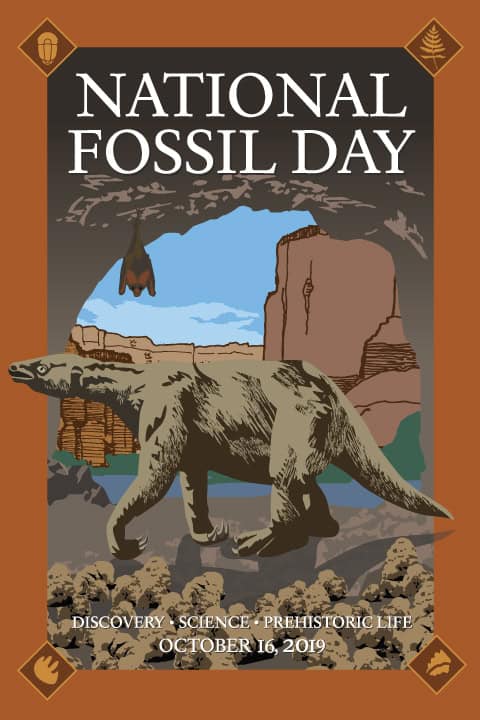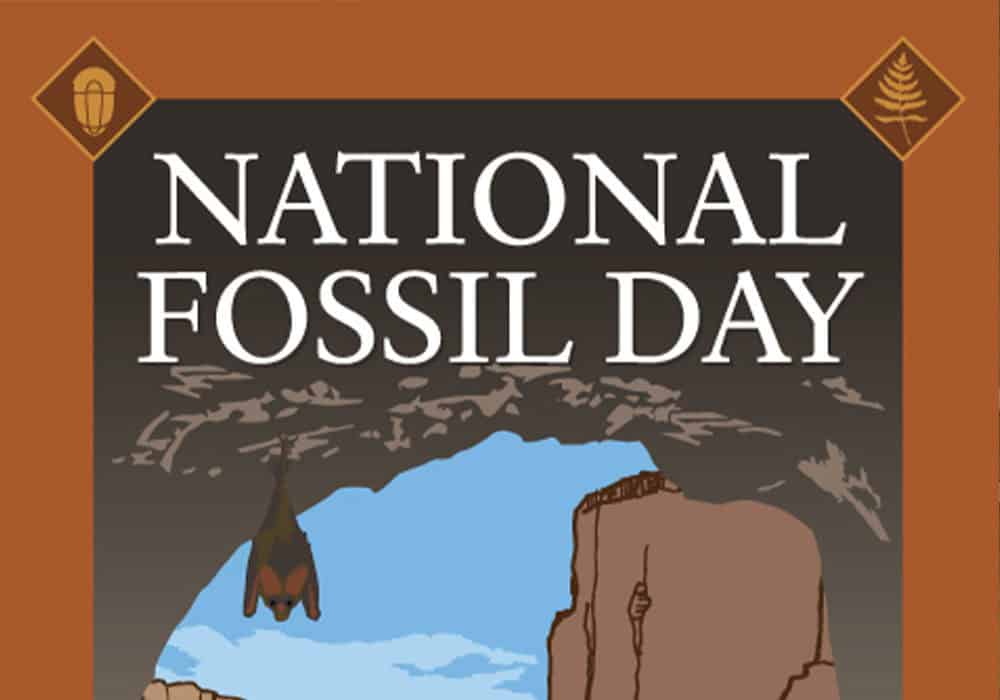Fascinated by fossils? Wednesday, October 16, 2019, marks the 10th annual observance of National Fossil Day! In the spirit of the day, we are highlighting some of the more significant fossils found in the Greenway’s home state of Pennsylvania, as well as sharing where you can go to tap into your inner paleontologist along the Greenway. So grab a brush, your magnifying glass, and your imaginations as we explore some fascinating fossil facts and finds.
 History & 2019 NPS Feature Fossil
History & 2019 NPS Feature Fossil
Founded by the National Park Service, this day highlights the scientific and educational value of paleontology and the importance of preserving fossils for future generations. Since its inception in 2010, National Fossil Day has been a special time for the National Park Service and nearly 300 partnering organizations to join together to educate the public about the value of fossils.
This year’s Fossil Day logo honors the 100th anniversary of the establishment of the Grand Canyon National Park, which occurred on February 26th, 1919 by President Woodrow Wilson. Over millions of years, the Colorado River and its tributaries have carved the canyon, cutting through geologic layers revealing rich fossil records. The logo features notable Paleozoic fossils from Grand Canyon National Park, but the focal point is a Shasta Ground Sloth, Nothrotheriops shastensis. The sloth is entering Rampart Cave 11,000 years ago while a vampire bat, Desmodus stocki, roosts in the cave ceiling while it awaits for nighttime to forage for food. To read more about this year’s featured fossils visit: www.nps.gov.
Pennsylvania’s Fossil Bed
Just like the Quetzalcoatlus northropi fossil’s location within the Javelina Formation, so too are the fossils of Pennsylvania found within a specific formation—the Devonian Mahantango Formation. Sandwiched between Marcellus shale on the bottom and Tully limestone on top, the Mahantango Formation was formed from the shallow Kaskaskia Sea which fluctuated in depth over time. Because of this tropical shallow sea environment, the most commonly found fossils include corals, brachiopods, cephalopods, and trilobites. More information on the history and geology of this formation can be found here.
Historic Pennsylvania Fossil Finds
Due to this unique geological history, Pennsylvania has seen the discovery of many important fossils over the years. One earlier example includes the SMP VP-12 fossil, which was eventually identified as Holonema rugosum—an ancient armored fish that once lived in Pennsylvania. The discovery was made by farmer, A. Carter, in Susquehanna County back in 1882 when he struck the unusual rock while ploughing fields. The rock was eventually shown to paleontologists who classified the specimen as a type of ancient fish called an arthrodire, a group of fish known to have armor plating covering their bodies, similar to crustaceans such as crabs and lobsters. These creatures patrolled the seas over Pennsylvania around 370 million years ago during the Devonian Period, some of which could grow to the size of a school bus.

Another, more recent, find in Pennsylvania was discovered in 2002 by Jennifer Elick, an assistant professor of geological and environmental sciences at Susquehanna University. In what is now Bradford County, Elick had found an ancient Sarcopterygiian, or lobe-finned fish, in the Wyalusing Rocks in northeast Pennsylvania. The discovery of this fossils is believed to be evidence that the area was once a tropical river delta, sitting at the border of land and sea. Since then, Elick has found several other plant and animal fossils at the Wyalusing Rocks, all dating back to the late Devonian period—a time before dinosaurs ruled the earth.
Fossil Hunting in Pennsylvania
As you can see, Pennsylvania is home to a treasure trove of fossils that date back hundreds of millions of years. The best thing is, you don’t have to be a scientist to find them! There are many locations of exposed shale around the state that allow the public to hunt fossils to their heart’s content.
One of the best-known sites is The Montour Fossil Pit in Danville, PA, which is a part of the greater PPL Montour Environmental Preserve. The Preserve is open sunrise to sunset, and visitors are encouraged to bring along basic fossil-hunting tools, such as a small geologist’s hammer, soft brush, safety goggles, a bag or bucket to carry fossils, and newspaper or other material to wrap the fossils for safekeeping.
Another fossil hunting destination, located a bit further south, is the Suedberg Fossil Site in Swarata State Park, PA. Again, visitors are encouraged to bring their own tools.
To learn more about the geology of Swatara State Park, see DCNR’s Trail of Geology publication.
Even York County has an array of opportunities to find both plant and animal fossils. Here, fossil hunters most often dig into the Kinzers Formation of the Lower Cambrian period. Click here for specific fossil-rich locations around York and Lancaster Counties.
If you have an eye for fossils check out this online forum. One user notes that you can find fossils on the Susquehanna River islands occasionally, “[you] just have to know the right rock to look for.”


